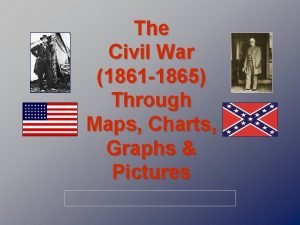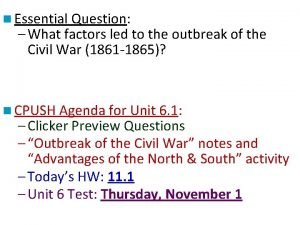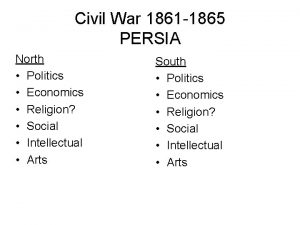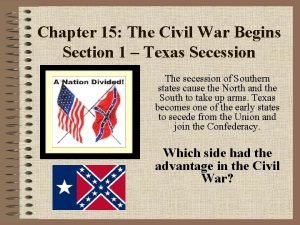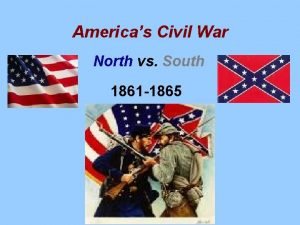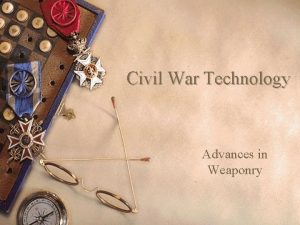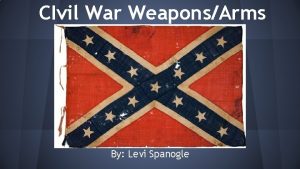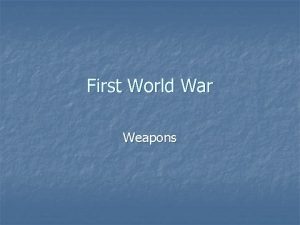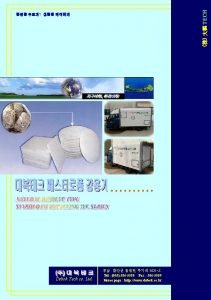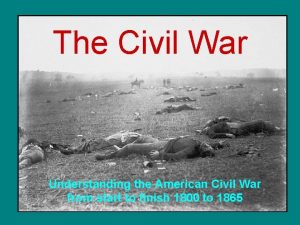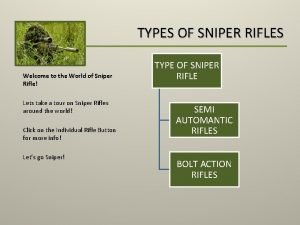American Civil War Civil War Tech Rifles and















- Slides: 15

American Civil War

Civil War Tech - Rifles and Minie Balls • Minie Ball was developed in France by Claude Minié in 1849 to take advantage of improved rifled weapons • Ammunition was much more accurate over a longer distance, roughly 600 yards (1/3 of a mile). Think Nerf gun vs. paper wad • IMPACT = When combined with outdated tactics creates much higher death tolls and much worse wounds than previous wars

Civil War Tech - Railroads • First railroads in the US appear in the 1820’s with the Industrial Revolution • By 1861, the North possessed 22, 000 miles of railroads compared to 9, 500 miles in the South. • IMPACT = Faster supply and troop movement over longer distances.

Civil War Tech - Telegraph • Samuel Morse develops technology to send messages by using electric pulses in short bursts and long bursts. • Allows people to send messages instantly across large distances. • IMPACT= Better communication between leaders and armies in the war, also better newspaper reporting

Morse Code Activity . -. /. --. . .

First Shots of the Civil War, 1861

II. Advantages NORTH § 13 million MORE people than the South § Industrial powerhouse § Railroads § Navy SOUTH • Home court • Strong military leaders • Fighting for way of life • Defensive war, just DO NOT LOSE

III. Disadvantages NORTH SOUTH • Capital city in MD • No industry or war (caught between 2 sides) • Union generals were inexperienced – Ulysses Grant & William Sherman production • No strong central government • Dependent on foreign trade for supply and

Northern Strategy for the War Anaconda Plan Use superior navy to close ports and prevent trade Take Mississippi River and cut South in half Take Southern Capital

ü Lincoln wanted to preserve the Union ü His goal was to make the Confederacy rejoin the Union ü Ending slavery will not be a goal of Lincoln until 1863

Southern Strategy ØRemain separate from the Union ØForce North to give up fighting the war ØGet European support

The Course of the War Early in the war (1861 -1862), the South will win many victories, mostly due to superior leadership. By 1863, defeats at Vicksburg and Gettysburg will mark the turning point in the war. The Union’s superior industrial base and larger armies will slowly defeat the Confederacy. Lee will surrender to Grant on April 11, 1865 at Appomattox Courthouse, Virginia

Women in the War • Some women dressed as men and fought • Most women took over farms, plantations, and stores while men were at war. • 3000 women, like Clara Barton, will join the Union army as nurses.

War • Slaves supported South by working on plantations, supplying food, and freeing white men to fight. • Escaped slaves were used by the North as laborers to build forts and drive

• After the Emancipation Proclamation, many African Americans joined the Union army. • Eventually 180, 000 African Americans will serve in the Union Army.
 Aot rifles
Aot rifles Chapter 16 lesson 2 challenges to slavery
Chapter 16 lesson 2 challenges to slavery Who were abolitionists
Who were abolitionists Low tech assistive technology
Low tech assistive technology Why was the civil war the first modern war
Why was the civil war the first modern war Civil rights and civil liberties webquest
Civil rights and civil liberties webquest Athena net
Athena net Civil war advantages and disadvantages chart
Civil war advantages and disadvantages chart Unit 4 civil war and reconstruction
Unit 4 civil war and reconstruction Civil war and reconstruction study guide
Civil war and reconstruction study guide Civil war advantages and disadvantages chart
Civil war advantages and disadvantages chart States rights
States rights North and south states civil war
North and south states civil war Us north vs south
Us north vs south Chapter 6 civil war and reconstruction
Chapter 6 civil war and reconstruction Remembering dred scott achieve 3000
Remembering dred scott achieve 3000


